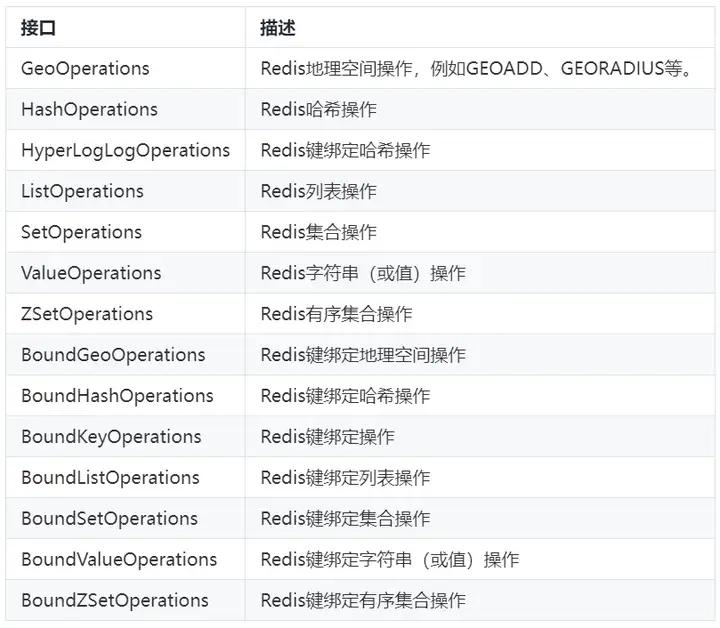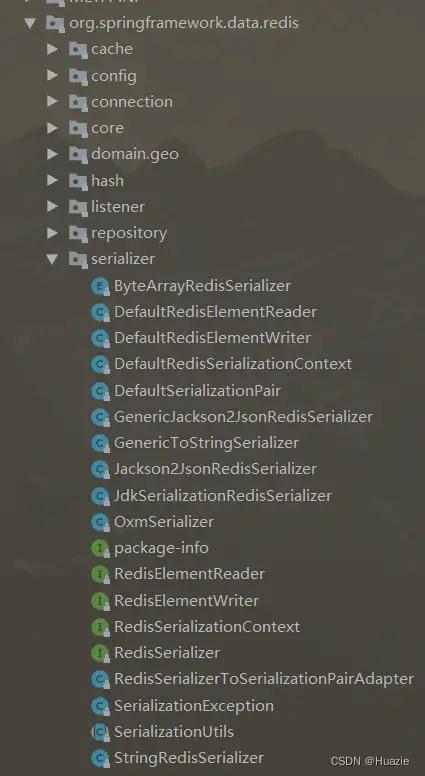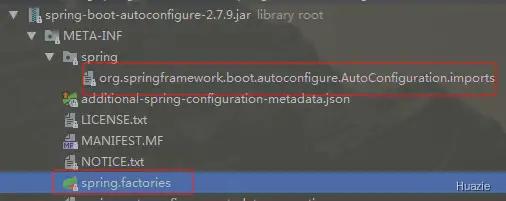
详解Spring Boot的RedisAutoConfiguration配置
引言
带大家分析 Spring Boot 内置的有关 Redis 的自动配置类【RedisAutoConfiguration】。
1. Spring Data Redis
Spring Data Redis 是 Spring Data 家族的一部分,它提供了从 Spring 应用程序中轻松配置和访问 Redis 的功能。
我们来看看官方介绍的特性:
- 连接包作为多个 Redis 驱动程序( Lettuce 和 Jedis )的低级别抽象。
- 将 Redis 驱动程序异常转换为 Spring 的可移植数据访问异常层次结构。
- 提供各种 Redis 操作、异常转换和序列化支持的 RedisTemplate。
- 支持发布订阅(例如用于消息驱动 POJO 的消息监听器容器)。
- 支持 Redis Sentinel 和 Redis Cluster。
- 使用 Lettuce 驱动程序的响应式 API。
- 支持 JDK、String、JSON和 Spring 对象 / XML 映射序列化器。
- 在 Redis 上实现 JDK 集合。
- 支持原子计数器类。
- 支持排序和管道功能。
- 专用于 SORT、SORT/GET模式和支持返回批量值的功能。
- 为 Spring 缓存抽象提供 Redis 实现。
- 自动实现 Repository 接口,包括使用 @EnableRedisRepositories 支持自定义查询方法。
- 对存储库提供 CDI 支持。
在 Spring Data Redis 中,我们可以直接使用 RedisTemplate 及其相关的类来操作 Redis。虽然 RedisConnection 提供了接受和返回二进制值(字节数组)的低级方法,但 RedisTemplate 负责序列化和连接管理,使用户可以无需处理这些细节。
RedisTemplate 还提供了操作视图(按照 Redis 命令参考进行分组),这些视图提供了丰富、通用的接口,用于针对特定类型或特定键进行操作(通过 KeyBound 接口实现),如下表所示:

下面我们来看看相关的 Spring 配置:
<?xml version="1.0" encoding="UTF-8"?>
<beans xmlns="http://www.springframework.org/schema/beans"
xmlns:xsi="http://www.w3.org/2001/XMLSchema-instance"
xmlns:p="http://www.springframework.org/schema/p"
xsi:schemaLocation="http://www.springframework.org/schema/beans https://www.springframework.org/schema/beans/spring-beans.xsd">
<bean id="jedisConnFactory" class="org.springframework.data.redis.connection.jedis.JedisConnectionFactory" p:use-pool="true"/>
<!-- redis 模板定义 -->
<bean id="redisTemplate" class="org.springframework.data.redis.core.RedisTemplate" p:connection-factory-ref="jedisConnFactory"/>
</beans>一旦配置完成,Redis 模板就是线程安全的,并且可以在多个实例之间重用。
RedisTemplate 使用基于 Java 的序列化器进行大部分操作。也就意味着通过模板写入或读取的任何对象都是通过 Java 进行序列化和反序列化的。
我们也可以更改模板上的序列化机制,可以添加如下配置:
<bean id="redisTemplate" class="org.springframework.data.redis.core.RedisTemplate">
<property name="connectionFactory" ref="redisConnectionFactory"/>
<property name="keySerializer">
<bean class="org.springframework.data.redis.serializer.StringRedisSerializer"/>
</property>
<property name="valueSerializer">
<bean class="org.springframework.data.redis.serializer.JdkSerializationRedisSerializer"/>
</property>
<property name="hashKeySerializer">
<bean class="org.springframework.data.redis.serializer.StringRedisSerializer"/>
</property>
<property name="hashValueSerializer">
<bean class="org.springframework.data.redis.serializer.JdkSerializationRedisSerializer"/>
</property>
</bean>而 Redis 模块提供了几个序列化器的实现,有关这些实现大家可以查看 org.springframework.data.redis.serializer 包。

还可以将任何序列化程序设置为 null,并通过设置 enableDefaultSerializer 属性为 false 来使用RedisTemplate 与原始字节数组一起使用。
注意: 模板要求所有键都不为空。但是,只要底层序列化程序接受值,值就可以为空。
下面我们可以注入 RedisTemplate,并调用 RedisTemplate 的方法进行存储、查询、删除等操作。
@Autowired
private RedisTemplate<String, Object> redisTemplate;
// 存储数据
redisTemplate.opsForValue().set("key", "value");
// 查询数据
Object value = redisTemplate.opsForValue().get("key");
// 删除数据
redisTemplate.delete("key");对于需要特定模板视图的情况,声明视图作为依赖项并注入模板。容器会自动执行转换,消除opsFor[X] 调用,如下所示的示例:
public class Example {
// inject the template as ListOperations
@Resource(name="redisTemplate")
private ListOperations<String, String> listOps;
public void addLink(String userId, URL url) {
listOps.leftPush(userId, url.toExternalForm());
}
}当然 Spring Data Redis 肯定不止上述这些,有需要深入了解的读者们,请看如下:
参考: Spring Data Redis 官方文档
2. RedisAutoConfiguration
那么 Spring Data Redis 的 RedisTemplate 的自动配置在 Spring Boot 是如何实现的呢?
Spring Boot 是通过内置的 RedisAutoConfiguration 配置类来完成这一功能。下面我们具体分析一下:
注意: 以下涉及 Spring Boot 源码 均来自版本 2.7.9,其他版本有所出入,可自行查看源码。
2.1 加载自动配置组件
从之前的《【Spring Boot 源码学习】自动装配流程源码解析(上)》中,我们知道 Spring Boot 内部针对自动配置类,会读取如下两个配置文件:
- META-INF/spring.factories
- META-INF/spring/org.springframework.boot.autoconfigure.AutoConfiguration.imports

实际上 在 Spring Boot 2.7.9 版本中, Spring Boot 自己内部的 META-INF/spring.factories 中有关自动配置的注册类的配置信息已经被去除掉了,不过其他外围的 jar 中可能有自己的 META-INF/spring.factories 文件,它里面也有关于自动配置注册类的配置信息;
而 Spring Boot 内置的 RedisAutoConfiguration 配置类,则是配置在上述的第二个配置文件 META-INF/spring/org.springframework.boot.autoconfigure.AutoConfiguration.imports 中。

2.2 过滤自动配置组件
上述自动配置加载完之后,就来到了 《【Spring Boot 源码学习】自动装配流程源码解析(下)》 介绍的 过滤自动配置组件 逻辑。
这部分数据对应的配置内容在 META-INF/spring-autoconfigure-metadata.properties 文件中:
org.springframework.boot.autoconfigure.data.redis.RedisAutoConfiguration=
org.springframework.boot.autoconfigure.data.redis.RedisAutoConfiguration.ConditionalOnClass=org.springframework.data.redis.core.RedisOperations显然这里涉及到了 ConditionalOnClass 注解,我们翻看 RedisAutoConfiguration 配置类的源码,如下:
@AutoConfiguration
@ConditionalOnClass(RedisOperations.class)
@EnableConfigurationProperties(RedisProperties.class)
@Import({ LettuceConnectionConfiguration.class, JedisConnectionConfiguration.class })
public class RedisAutoConfiguration {
@Bean
@ConditionalOnMissingBean(name = "redisTemplate")
@ConditionalOnSingleCandidate(RedisConnectionFactory.class)
public RedisTemplate<Object, Object> redisTemplate(RedisConnectionFactory redisConnectionFactory) {
// 。。。
}
@Bean
@ConditionalOnMissingBean
@ConditionalOnSingleCandidate(RedisConnectionFactory.class)
public StringRedisTemplate stringRedisTemplate(RedisConnectionFactory redisConnectionFactory) {
// 。。。
}
}2.2.1 涉及注解
我们先来看看上述 RedisAutoConfiguration 配置类涉及到的注解,如下:
- @AutoConfiguration : 该类是一个自动配置类,Spring Boot 会根据项目中的依赖自动配置这个类的实例。
- @ConditionalOnClass(RedisOperations.class) :只有在项目中引入了 RedisOperations 类(通常由 spring-data-redis 库提供)的情况下,才会加载这个配置类。
- @EnableConfigurationProperties(RedisProperties.class) :启用RedisProperties 类作为配置属性。这样,我们就可以在 application.properties 或application.yml 文件中定义 Redis 的相关配置。
- @Import({ LettuceConnectionConfiguration.class, JedisConnectionConfiguration.class }) :导入注解,表示导入 LettuceConnectionConfiguration 和 JedisConnectionConfiguration 这两个类。这两个类通常用于配置 Redis 连接的具体实现,例如使用 Lettuce 还是 Jedis 等。
- @Bean :用于声明一个方法创建的对象是一个 Spring 管理的 Bean。Spring 容器会自动管理这个 Bean 的生命周期,包括依赖注入、初始化和销毁等。
- @ConditionalOnMissingBean :只有在当前 Spring 容器中不存在指定类型的 Bean 时,才会执行被注解的方法。这样可以用于确保在需要的时候才创建某个 Bean,避免重复创建。
- @ConditionalOnSingleCandidate:只有在当前上下文中存在且只有一个指定类型的 bean 候选者时,才会创建这个 bean。
2.2.2 RedisProperties
其中 RedisProperties 类的属性值对应着 application.yml 或 application.properties 中的配置,通过注解@ConfigurationProperties(prefix = "spring.redis") 实现的属性注入。
有关属性注入的内容后续笔者会另外介绍,我们先来看看RedisProperties 类相关的部分源码 和 对应的配置参数:
@ConfigurationProperties(prefix = "spring.redis")
public class RedisProperties {
// 。。。
// Redis 服务器主机地址.
private String host = "localhost";
// 。。。
// Redis 服务器的端口
private int port = 6379;
private Sentinel sentinel;
private Cluster cluster;
private final Jedis jedis = new Jedis();
private final Lettuce lettuce = new Lettuce();
// Redis 连接池配置
public static class Pool {
// 。。。
}
// Redis 集群配置
public static class Cluster {
// 。。。
}
// Redis 哨兵配置
public static class Sentinel {
// 。。。
}
// Jedis 客户端配置
public static class Jedis {
// Jedis 连接池配置
private final Pool pool = new Pool();
}
// Lettuce 客户端配置
public static class Lettuce {
// Lettuce 连接池配置
private final Pool pool = new Pool();
private final Cluster cluster = new Cluster();
}
}然后在 application.properties 中,我们就可以添加类似如下的配置:
本文系作者在时代Java发表,未经许可,不得转载。
如有侵权,请联系nowjava@qq.com删除。
